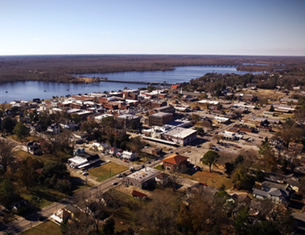Boldly Committed to Truth Telling in the False Face of Fakery
John Glenn: The "Clean Marine"
Publisher's note: The day after former U.S. Senator John Glenn's death, December 8, 2016, I paid my respects to America's first astronaut to orbit the Earth on Facebook. Today, on BCN, I will publish my comments, but also, I will take it one step further by sharing NASA's profile of Colonel John Glenn, along with captioned images, and a couple of videos of some of this Astronaut's remarkable achievements.
Today, I pay my greatest respects and deep appreciation, as I celebrate the life of a wonderful patriot, and a Democrat at that ... When was the last time I had this opportunity?
This tribute is for a true American patriot ... a super patriot - Senator John Glenn, Ohio.
Future Senator John Glenn was a World War II warrior as a Marine pilot in the Pacific, and when that was not enough; there was Korea, flying the early jets over enemy skies. And when that ended, he was one of the first jet test pilots, just after the Chuck Yeager class of those super brave test pilots, who broke the Sound Barrier and beyond.

Flight Training - Astronaut John H. Glenn in the cockpit of a T-106 preparing for training exercises in flight proficiency. Click image to expand.
And when flying these early planes more than 4 times faster than those fighter prop planes that were catapulted off those early aircraft carriers was not enough, he volunteered to be one of the first 7 fighter pilots to be shot into space in a veritable tin can.

Climb Aboard - Astronaut John H. Glenn, Jr., pilot of the Mercury-Atlas 6 (MA-6) space flight, enters the Mercury "Friendship 7" spacecraft during the MA-6 pre-launch preparations at Cape Canaveral, Florida. Click image to expand.
May God grant perfect peace to the "Clean Marine".
He was one of our greatest Americans, and if all Democrats were like John Glenn, I would stand in a long line to sign up to be one myself. What a great guy. What an inspiration to us all as such a great man.
Our nation is far better for having him as that brave, quiet leader of men, and hero to young boys like me.
Former astronaut and U.S. Senator John Glenn died Thursday at the Ohio State University Wexner Medical Center in Columbus.
Glenn, who served four terms as a U.S. senator from Ohio, was one of NASA's original seven Mercury astronauts. His flight on Friendship 7 on Feb. 20, 1962, showed the world that America was a serious contender in the space race with the Soviet Union. It also made Glenn an instant hero.
His mission of almost nine days on the space shuttle orbiter Discovery, launched Oct. 29, 1998, when he was 77, made him the oldest human to venture into space. On Discovery he participated in a series of tests on the aging process. The aging population was one focus of his work as a U.S. senator.

Launch of Shuttle Discovery on STS-95 Mission - As if sprung from the rolling exhaust clouds below, Space Shuttle Discovery shoots into the heavens over the blue Atlantic Ocean from Launch Pad 39B on mission STS-95. Discovery carries a crew of six, including Payload Specialist John H. Glenn Jr., senator from Ohio, who is making his second voyage into space after 36 years. Click image to expand.
Glenn was described as "humble, funny, and generous" by Trevor Brown, dean of the John Glenn School of Public Affairs at Ohio State University, in a statement joined by the Glenn family. "Even after leaving public life, he loved to meet with citizens, school children in particular. He thrilled to music and had a weakness for chocolate."
Glenn will always be remembered as the first American to orbit the Earth during those tentative, challenging, daring days when humans were just beginning to venture beyond the atmosphere that had nurtured them since the species began.

John Glenn's Dress Rehearsal - Rehearsing for his historic flight on February 20, 1962, Mercury program astronaut John H. Glenn Jr. works in a cramped training capsule preparing for his voyage through space. Click image to expand.
While Glenn's flight on Friendship 7 was a glorious national triumph, problems arose that could have spelled disaster. The first was a failure of the automatic control system.
A scheduled 30-minute test to determine whether Glenn could fly the capsule manually became a matter of life and death when the automatic system went out at the end of the first orbit.
"I went to manual control and continued in that mode during the second and third orbits, and during re-entry," Glenn recalled later. He had been confident he could do it.
"The malfunction just forced me to prove very rapidly what had been planned over a longer period of time."
Another problem seemed even more serious -- telemetry indicated the spacecraft's heat shield was loose. It seemed possible that Glenn and the spacecraft would be incinerated on re-entry. Much of the world held its breath.
Glenn left the retrorocket pack in place to steady the heat shield during re-entry. "It made for a very spectacular re-entry from where I was sitting," he said. Big chunks of the burning material came flying by the window.
He wasn't sure whether the flaming debris was the rocket pack or the heat shield breaking up. "Fortunately," he told an interviewer, "it was the rocket pack -- or I wouldn't be answering these questions."
From Ohio to Orbit
John Herschel Glenn Jr. was born July 18, 1921, in Cambridge, Ohio. He attended primary and secondary schools in New Concord, Ohio. He received a bachelor of science degree in engineering from Muskingum College in New Concord.
Muskingum College is among nine colleges or universities that subsequently awarded him honorary doctoral degrees.
Glenn entered the Naval Aviation Cadet Program in March 1942. He graduated and was commissioned in the Marine Corps in 1943. After advanced training, he joined Marine Fighter Squadron 155 and spent a year flying F-4U fighters in the Marshall Islands. He flew 59 combat missions during World War II.
After the war, he was a member of Marine Fighter Squadron 218 on the North China patrol and served on Guam. From June 1948 to December 1950 he served as an instructor in advanced flight training at Corpus Christi, Texas. He then attended Amphibious Warfare Training at Quantico, Va.
In Korea he flew 63 missions with Marine Fighter Squadron 311. As an exchange pilot with the Air Force Glenn flew 27 missions in the F-86 Sabre. In the last nine days of fighting in Korea, Glenn shot down three MiGs in combat along the Yalu River.
Then-Senator Glenn joined the STS-95 Discovery crew in 1998, becoming the oldest person to fly in space at 77.
Go Back
Today, I pay my greatest respects and deep appreciation, as I celebrate the life of a wonderful patriot, and a Democrat at that ... When was the last time I had this opportunity?
This tribute is for a true American patriot ... a super patriot - Senator John Glenn, Ohio.
Future Senator John Glenn was a World War II warrior as a Marine pilot in the Pacific, and when that was not enough; there was Korea, flying the early jets over enemy skies. And when that ended, he was one of the first jet test pilots, just after the Chuck Yeager class of those super brave test pilots, who broke the Sound Barrier and beyond.

And when flying these early planes more than 4 times faster than those fighter prop planes that were catapulted off those early aircraft carriers was not enough, he volunteered to be one of the first 7 fighter pilots to be shot into space in a veritable tin can.

May God grant perfect peace to the "Clean Marine".
He was one of our greatest Americans, and if all Democrats were like John Glenn, I would stand in a long line to sign up to be one myself. What a great guy. What an inspiration to us all as such a great man.
Our nation is far better for having him as that brave, quiet leader of men, and hero to young boys like me.
NASA Profile of John Glenn
Former astronaut and U.S. Senator John Glenn died Thursday at the Ohio State University Wexner Medical Center in Columbus.
Glenn, who served four terms as a U.S. senator from Ohio, was one of NASA's original seven Mercury astronauts. His flight on Friendship 7 on Feb. 20, 1962, showed the world that America was a serious contender in the space race with the Soviet Union. It also made Glenn an instant hero.
His mission of almost nine days on the space shuttle orbiter Discovery, launched Oct. 29, 1998, when he was 77, made him the oldest human to venture into space. On Discovery he participated in a series of tests on the aging process. The aging population was one focus of his work as a U.S. senator.

Glenn was described as "humble, funny, and generous" by Trevor Brown, dean of the John Glenn School of Public Affairs at Ohio State University, in a statement joined by the Glenn family. "Even after leaving public life, he loved to meet with citizens, school children in particular. He thrilled to music and had a weakness for chocolate."
Glenn will always be remembered as the first American to orbit the Earth during those tentative, challenging, daring days when humans were just beginning to venture beyond the atmosphere that had nurtured them since the species began.

While Glenn's flight on Friendship 7 was a glorious national triumph, problems arose that could have spelled disaster. The first was a failure of the automatic control system.
A scheduled 30-minute test to determine whether Glenn could fly the capsule manually became a matter of life and death when the automatic system went out at the end of the first orbit.
"I went to manual control and continued in that mode during the second and third orbits, and during re-entry," Glenn recalled later. He had been confident he could do it.
"The malfunction just forced me to prove very rapidly what had been planned over a longer period of time."
Another problem seemed even more serious -- telemetry indicated the spacecraft's heat shield was loose. It seemed possible that Glenn and the spacecraft would be incinerated on re-entry. Much of the world held its breath.
Glenn left the retrorocket pack in place to steady the heat shield during re-entry. "It made for a very spectacular re-entry from where I was sitting," he said. Big chunks of the burning material came flying by the window.
He wasn't sure whether the flaming debris was the rocket pack or the heat shield breaking up. "Fortunately," he told an interviewer, "it was the rocket pack -- or I wouldn't be answering these questions."
From Ohio to Orbit
John Herschel Glenn Jr. was born July 18, 1921, in Cambridge, Ohio. He attended primary and secondary schools in New Concord, Ohio. He received a bachelor of science degree in engineering from Muskingum College in New Concord.
Muskingum College is among nine colleges or universities that subsequently awarded him honorary doctoral degrees.
Glenn entered the Naval Aviation Cadet Program in March 1942. He graduated and was commissioned in the Marine Corps in 1943. After advanced training, he joined Marine Fighter Squadron 155 and spent a year flying F-4U fighters in the Marshall Islands. He flew 59 combat missions during World War II.
After the war, he was a member of Marine Fighter Squadron 218 on the North China patrol and served on Guam. From June 1948 to December 1950 he served as an instructor in advanced flight training at Corpus Christi, Texas. He then attended Amphibious Warfare Training at Quantico, Va.
In Korea he flew 63 missions with Marine Fighter Squadron 311. As an exchange pilot with the Air Force Glenn flew 27 missions in the F-86 Sabre. In the last nine days of fighting in Korea, Glenn shot down three MiGs in combat along the Yalu River.
Then-Senator Glenn joined the STS-95 Discovery crew in 1998, becoming the oldest person to fly in space at 77.
Comments
|
My pleasure, but the story wrote itself, and then I just organized it all.
You know all about the organization part B.T., and thanks for that. |
|
Thanks for this definitive story of a man of America who accomplished much with humility, determination and a willingness to endure great risk in pursuit of a goal. Hopefully, his life and passing will serve to illuminate the greatness that was and still is in the American Character.
|
| "Oh, Christmas Tree" | Deaths, In the Past, Body & Soul | What was it like to be buttoned up in a phone booth and shot into space |























USNS John Glenn (T-ESD-2)